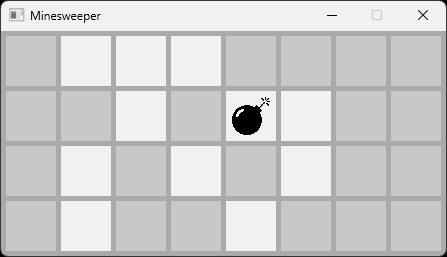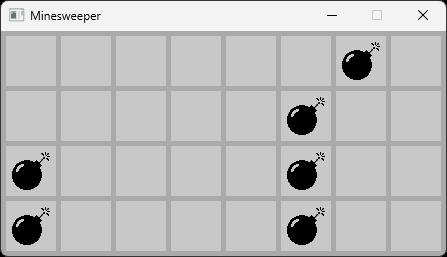Adding Bombs to the Grid
Updating the game to to place bombs randomly in the grid and render them when cells are cleared.
In this part, we'll build upon our existing code to add the key element of the game: bombs. We'll implement the ability to place bombs randomly within our grid and reveal them when cells containing bombs are cleared.
We'll start by updating our global configurations to include new variables for bomb-related events and settings. Then, we'll modify our grid and cell classes to handle bomb placement and rendering.
By the end of this section, you'll have a Minesweeper grid where bombs can be placed and revealed, setting the stage for implementing the game's core mechanics in future parts.
Starting Point
Our project already has a grid of interactive cells that can be "cleared" by clicking on them. This lesson will build upon these files, which we've already created earlier in the course:
Files
To render our bomb images, we'll use the Engine::Image class we introduced previously.
To place bombs randomly within our grid, we'll use the Engine::Random namespace.
Updating Globals
To begin implementing bombs in our game, we'll first update our Globals.h file with some new variables. These additions will help us manage bomb-related events and configure the game's difficulty:
UserEvents::BOMB_PLACED: This new event type will be dispatched whenever a bomb is placed within a cell. This will allow other cells to keep track of how many bombs are in adjacent cells, which we'll use later to display the correct number.Config::BOMB_COUNT: This variable will control how many bombs are placed in the grid. By adjusting this number, we can change the difficulty of the game - more bombs means a more challenging game.- We'll also use
Config::BOMB_IMAGE, which was included in our initial config file. This string specifies the file name of the icon we want to render in cells that contain a bomb. By defining this in our global configuration, we can easily change the bomb image across our entire game if needed.
src/Globals.h
#pragma once
#define SHOW_DEBUG_HELPERS
#include <iostream>
#include <SDL3/SDL.h>
#include <string>
namespace UserEvents{
inline const Uint32 CELL_CLEARED{
SDL_RegisterEvents(1)};
inline const Uint32 BOMB_PLACED{
SDL_RegisterEvents(1)};
}
namespace Config{
// Game Settings
inline const std::string GAME_NAME{
"Minesweeper"};
inline constexpr int BOMB_COUNT{6};
inline constexpr int GRID_COLUMNS{8};
inline constexpr int GRID_ROWS{4};
// ... (rest of Config namespace)
// Asset Paths
inline const std::string BASE_PATH{
SDL_GetBasePath()};
inline const std::string BOMB_IMAGE{
BASE_PATH + "Bomb.png"};
inline const std::string FLAG_IMAGE{
BASE_PATH + "Flag.png"};
inline const std::string FONT{
BASE_PATH + "Roboto-Medium.ttf"};
}
// ... (rest of file)Dealing with Invalid Configurations
When working with our game configuration, it's possible to inadvertently create an invalid setup. For example, imagine if we set BOMB_COUNT to be greater than the total number of cells in our grid:
inline constexpr int BOMB_COUNT{100};
inline constexpr int GRID_COLUMNS{8};
inline constexpr int GRID_ROWS{4};In this case, we're trying to place 100 bombs in a grid with only 32 cells (8 x 4), which is impossible.
You might want to check for invalid configurations. One way of doing this is with static_assert. This is a compile-time check that ensures certain conditions are met before the program can be compiled.
Here's how static_assert works:
- It takes two arguments: a boolean condition and an error message.
- If the condition is false, compilation fails with the provided error message.
- The condition must be known at compile-time, which our
constexprconfig variables satisfy.
Here's an example of how you could use static_assert to prevent this invalid configuration:
src/Globals.h
// ...
namespace Config{
// Game Settings
inline constexpr int BOMB_COUNT{100};
inline constexpr int GRID_COLUMNS{8};
inline constexpr int GRID_ROWS{4};
static_assert(
BOMB_COUNT < GRID_COLUMNS * GRID_ROWS,
"Cannot have more bombs than cells"
);
// ...
}
// ...The compiler will now alert us to this invalid configuration:
Error: static_assert failed: Cannot have more bombs than cellsPlacing Bombs in Random Cells
To implement bomb placement in our grid, we'll update our MinesweeperGrid class with a new PlaceBombs() function. This function will be responsible for randomly selecting cells and placing bombs in them.
Here's how the PlaceBombs() function will work:
- We'll create a loop that continues until we've placed the required number of bombs (specified by
Config::BOMB_COUNT). - In each iteration, we'll select a random index from our
Childrenvector, which contains all the cells in our grid. - We'll call a new
PlaceBomb()function (which we'll add to ourMinesweeperCellclass later) on the randomly selected cell. - If
PlaceBomb()returnstrue, indicating a successful bomb placement, we'll decrement our counter of bombs to place. - If
PlaceBomb()returnsfalse, indicating the selected cell already contains a bomb, we'll continue the loop to try placing the bomb in a different random cell.
This approach ensures that we place the correct number of bombs, and that no cell contains more than one bomb:
src/Minesweeper/Grid.h
#pragma once
#include <vector>
#include <SDL3/SDL.h>
#include "Globals.h"
#include "Minesweeper/Cell.h"
#include "Engine/Random.h"
class MinesweeperGrid {
// ...
private:
void PlaceBombs(){
int BombsToPlace{Config::BOMB_COUNT};
while (BombsToPlace > 0) {
const size_t RandomIndex{
Engine::Random::Int(
0, Children.size() - 1
)};
if (Children[RandomIndex].PlaceBomb()) {
--BombsToPlace;
}
}
}
std::vector<MinesweeperCell> Children;
};We'll call PlaceBombs() at the end of the MinesweeperGrid constructor.
src/Minesweeper/Grid.h
// ...
class MinesweeperGrid {
public:
MinesweeperGrid(int x, int y){
// ...
PlaceBombs();
}
// ...
};Updating Cells to Receive Bombs
Now that we've implemented bomb placement in our grid, we need to update our MinesweeperCell class to handle bombs. We'll make the following changes:
- Add a new
PlaceBomb()function that returns abool. This function will be called byMinesweeperGridwhen attempting to place a bomb in the cell. - Add a
hasBombmember variable to keep track of whether the cell contains a bomb. - Create a
GetHasBomb()getter function to allow other parts of our program to check if a cell contains a bomb without directly accessing thehasBombvariable.
Let's update our header file with these three declarations:
src/Minesweeper/Cell.h
#pragma once
#include <SDL3/SDL.h>
#include "Engine/Button.h"
#include "Engine/Image.h"
class MinesweeperCell : public Engine::Button {
public:
// ...
bool PlaceBomb();
[[nodiscard]]
bool GetHasBomb() const{ return hasBomb; }
// ...
private:
// ...
bool hasBomb{false};
// ...
};Over in our MinesweeperCell.cpp file, we'll implement the PlaceBomb() function. If the cell already has a bomb, we'll immediately return false, prompting the PlaceBombs() loop back in MinesweeperGrid to choose another cell.
Otherwise, we'll update our hasBomb member variable, report that a bomb has been placed, and return true to inform MinesweeperGrid that a bomb was successfully placed:
src/Minesweeper/Cell.cpp
#include <iostream>
#include <SDL3/SDL.h>
#include "Minesweeper/Cell.h"
#include "Globals.h"
// ...
bool MinesweeperCell::PlaceBomb(){
if (hasBomb) return false;
hasBomb = true;
ReportEvent(UserEvents::BOMB_PLACED);
return true;
}
// ...We'll also update our HandleEvent() function to react to bomb placement events.
For now, we'll just log that a bomb was placed, but in future parts, we'll use this to update the count of adjacent bombs for neighboring cells.
src/Minesweeper/Cell.cpp
// ...
void MinesweeperCell::HandleEvent(
const SDL_Event& E){
if (E.type == UserEvents::CELL_CLEARED) {
// TODO
std::cout << "A Cell Was Cleared\n";
} else if (E.type ==
UserEvents::BOMB_PLACED) {
// TODO
std::cout << "A Bomb was Placed\n";
}
Button::HandleEvent(E);
}
// ...We can now run our program and verify everything is connected correctly by looking at our terminal output. Every time a bomb is placed in a cell, every cell will react to the event, so we should see a long list of logs:
A Bomb was Placed
A Bomb was Placed
A Bomb was Placed
...We'll replace this logging with more meaningful reactions later.
Rendering Bomb Images
Finally, lets update our program to render the bomb images in the appropriate cells. We'll add a BombImage member variable. Because Engine::Image has its copy constructor deleted, we must store it as a pointer, such as a std::unique_ptr. This allows our MinesweeperCell to be movable, which is a requirement for it to be storable in a std::vector.
We'll create more elegant ways of handling images and other assets later in the course.
src/Minesweeper/Cell.h
#pragma once
#include <SDL3/SDL.h>
#include <memory>
#include "Engine/Button.h"
#include "Engine/Image.h"
class MinesweeperCell : public Engine::Button {
// ...
private:
//...
std::unique_ptr<Engine::Image> BombImage;
};Over in our constructor, we'll initialize our image. Our Engine::Image class needs to know the position (x and y) and size (w and h) we want the image to be rendered on the surface. It also needs to know the location of the image file on our hard drive. We'll pass all of this information to its constructor using std::make_unique:
src/Minesweeper/Cell.cpp
#include <iostream>
#include <memory>
#include <SDL3/SDL.h>
#include "Minesweeper/Cell.h"
#include "Globals.h"
MinesweeperCell::MinesweeperCell(
int x, int y, int w, int h, int Row, int Col)
: Button{x, y, w, h}, Row{Row}, Col{Col} {
BombImage = std::make_unique<Engine::Image>(
x, y, w, h,
Config::BOMB_IMAGE
);
};
// ...Finally, we update the Render() method of our MinesweeperCell. If the player has cleared the cell and the cell contains a bomb, we render the image:
src/Minesweeper/Cell.cpp
// ...
void MinesweeperCell::Render(
SDL_Surface* Surface){
Button::Render(Surface);
if (isCleared && hasBomb) {
BombImage->Render(Surface);
}
}
// ...If we run our game and clear cells, we should now eventually find a bomb:

Development Helpers
To make future development easier, it would be helpful to know where the bombs are without having to find them by clearing cells. In our Globals.h file, we created a preprocessor definition called SHOW_DEBUG_HELPERS.
We can use this preprocessor definition in our MinesweeperCell::Render() method to display bombs in all cells during development, regardless of whether they've been cleared:
src/Minesweeper/Cell.cpp
// ...
void MinesweeperCell::Render(
SDL_Surface* Surface){
Button::Render(Surface);
if (isCleared && hasBomb) {
BombImage->Render(Surface);
}
#ifdef SHOW_DEBUG_HELPERS
else if (hasBomb) {
BombImage->Render(Surface);
}
#endif
}
// ...When our preprocessor definition is enabled, we will be able to see bombs without clearing cells, which will make future development more convenient:

To enable these debug helpers, ensure the SHOW_DEBUG_HELPERS macro is defined in your Globals.h file. To disable them, simply comment out or remove the #define SHOW_DEBUG_HELPERS line:
src/Globals.h
// #define SHOW_DEBUG_HELPERS
// ...Creating development helpers and tools like this is generally a good idea. The more complex the project, the more effort we should put into creating these systems. They'll save us time in the long run, and make the experience of working on the project much more pleasant.
Complete Code
Complete versions of the files we changed in this part are available below.
Files
Files not listed above have not been changed since the previous section.
Summary
In this part of our tutorial, we've made progress in implementing one of the core elements of the game: bombs. We are now:
- Implementing a system for randomly placing bombs in the grid.
- Updating cells to track whether they contain a bomb.
- Rendering bomb images when cells are cleared.
- Adding a debug helper to visualize bomb placement during development.
In the next part of our tutorial, we'll build upon this foundation to implement the ability for cleared cells to display the number of bombs in neighboring cells. This feature provides players with the information they need to deduce the location of bombs and clear the grid safely.
We'll modify our cell class to keep track of neighboring bombs, update this count when bombs are placed, and display the count when a cell is cleared. This will involve working with events, updating our rendering logic, and introducing new graphical elements to represent the numbers.
Adjacent Cells and Bomb Counting
Implement the techniques for detecting nearby bombs and clearing empty cells automatically.